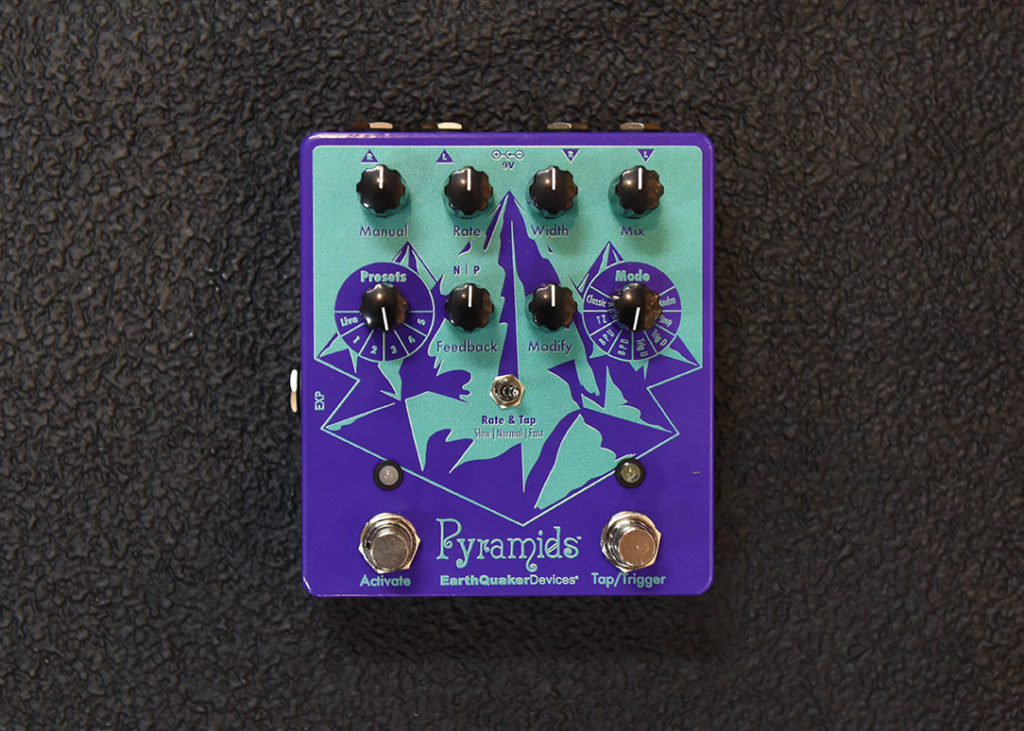By Alejandra Robles
When I actually started producing and recording my sound with synths and instruments other than drums, I noticed that I typically used the “Flanger” effect. I love the space and disorientation it provides. Drums are my main instrument, so I sometimes get overwhelmed by electronic instruments and the amount of audio information they display. Pyramids interface is very straightforward, and I really appreciate that. It’s very easy to have complete control because navigation through sounds is pretty seamless.
The layout consists of four top knobs which control the: delay, rate, width, and wetness. Below that on the left are built-in presets that you can modify or overwrite and then restore. I also must mention the bypass switch, because it’s not your typical bypass. By hitting it once, it turns on or off. But, if you push and hold, the effect will last until you release it.
On the right hand side under the top knobs, there’s the Mode Rotary switch where you can select from 8 different Flanger Modes: Classic, Through Zero, Barber Pole Up, Barber Pole Down, Trigger Up, Trigger Down, Step and Random. To me, this is the most important part of the pedal so I’m going to walk you through my experience with each mode.
“Classic” gives you an old school, analogue sound. “Through Zero” gives you negative frequencies that would otherwise disappear at Zero Point. “Barber Pole Up” gives you a Shepard tone which creates the auditory illusion of an endless ascending pitch. “Barber Pole Down” creates that same auditory illusion with a descending pitch. (Shepard tones are often used in movies to build tension, suspense or foreboding). “Trigger Up” allows you to produce a continuous upwards sweep that can be re-triggered by hitting the “tap” switch and “Trigger Down” is the opposite. “Step” sweeps up and down in increments while you control the glide between steps. Finally, “Random” has you in control of the glide of the steps sweeping up and down, but the increments are randomized. If you are like me and guitar is not your main instrument, these last two settings are specifically fun to play with since it can give a sense of endless guitar or bass strumming; allowing you to get creative on the drums.
Separating the “Presets” rotary switch and the “Mode” rotary switch are the “Feedback” and the “Modify” knob. The modify allows you to interact with the different modes (decay, sensitivity control, glide, high and low pass filter, etc.) Then right under that is the “rate and tap” switch. The middle is 1:1, and to the left your tap is divided for a slower time and to the right it is multiplied.
Finally, perhaps one of my favorite features of Pyramids (along with the Barber Pole Up, Barber Pole Down, Step and Random features) is the side-chain flanging. The input/output allows you to trigger the flanger using an external source. Try it with a drum machine and bass, it will take you to a new dimension.
Alejandra Robles is a drummer from Monterrey Mexico, based out of Los Angeles. She has spent most of 2018 touring around the world with her band Le Butcherettes, supporting The Flaming Lips, Death From Above 1979 and At the Drive-In. When she’s not on tour she is recording and producing indie bands Stars at Night and CocoVera at her studio in Downtown Los Angeles.
Psstttt, have you visited our web store? Check it out here for all your Tom Tom print & merch needs!


